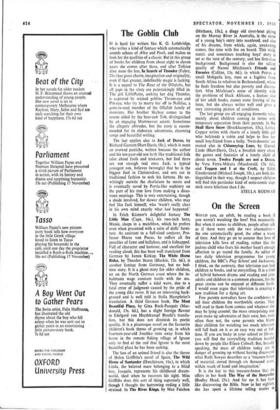On the Screen
WOULD you, an adult, be reading a book if you weren't watching the box? Not necessarily. But when it comes to children, people often talk as if there were only the two alternatives— the one automatically good, the other a waste of time. And they go on to assume that love of television kills love of reading, rather like the jealous child who fears his mother hasn't enough affection to go round the family. As editor of two daily television programmes for young children, the BBC's Play School and lackanoty, I think, on the contrary, that television can lead children to books, and to storytelling. It is a kind of hybrid between drama and reading and joins adults and children in a common pleasure, for the great stories can be enjoyed at different levels. I would even argue that television is creating a new tradition for a dying art.
Few parents nowadays have the confidence to tell their children the worthwhile stories. They will read to them from comics and whatever else may be lying around; the more enterprising may even make up adventures of their own; but, more often than not, the same parents who blame their children for watching too much television will fall back on it as an easy way out at bed- time. If you are lucky in your school or library, you will find the storytelling tradition handed
down by people like Eileen Colwell. But, broadly speaking, the mass of children today are in
danger of growing up without having discovered what Ruth Sawyer describes as a `treasure-house of material, stored through six thousand years, within reach of hand and imagination.' It is the key to this treasure-house that she offers in her book The Way of the Storyteller (Bodley Head, 25s.). And for me it has been like discovering the Bible. Now in her eighties, she has spent a lifetime telling stories io
America. Her principles illuminate both amateur and professional storytelling. I find them particularly reassuring in my own field, which has developed since her heyday and is something she does not discuss. But what she says is as true for television pro- ducers as it was for her old Nanny Johanna. For instance, she says that the good storyteller should choose only material of quality. The more catholic the choice, the better. But taste can be educated and must not be dulled by feed- ing on pap. The special contribution of television is that it can bring not only the Ruth Sawyers of storytelling to the child who might not other- wise seek the experience, but also the great actors and personalities and children's writers of our time.
I have found a story gains much in interest if there is something to tell of the people. the hero, the times, and the country before beginning.
Here again, television scores. A telescopic lens, the right music—and you are in a world of frost crystals and mirrors that sparkle before the Snow Queen.
Although nothing can ever replace the impact of the flesh-and-blood storyteller, television can be astonishingly intimate. I remember a colleague in sound radio, after years of disapproval, being converted to the new medium's possibilities be- cause she had seen the pulse ticking in Edith Evans's neck. If she had stayed to watch the results of concentrated storytelling on television over the last year she might have been even more excited. Letters from all kinds of children flow into our office asking for details of titles and authors and sending us pictures and ideas. Recently, in a library group, Jackanory addicts were asked, `Do you want to read the stories
for yourself afterwards?' Fourteen children out of sixty-one said 'No.' Ten said 'Sometimes.' And the rest—well over half—said 'Yes.' If you suspect the majority were just giving the answer they thought we wanted, ask other librarians. Ask the publishers. They at least know that far from being an enemy, the box is becoming the book's best friend.
JOY WHITBY







































 Previous page
Previous page